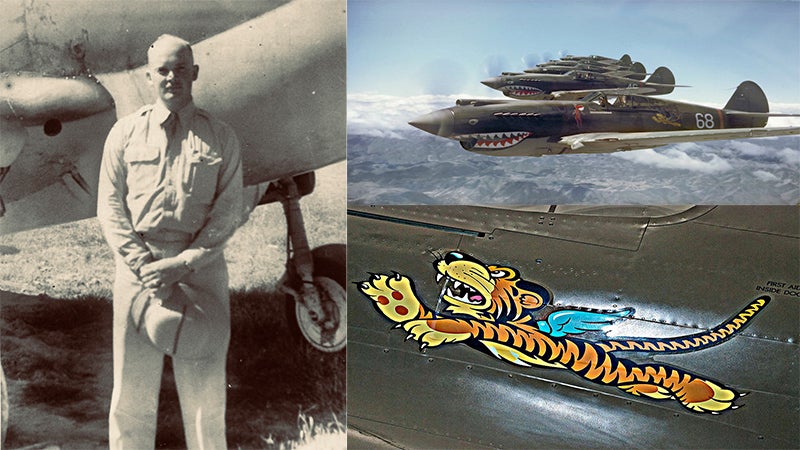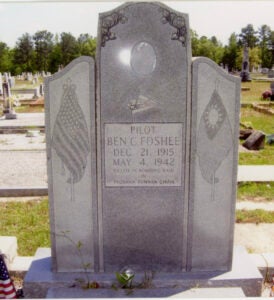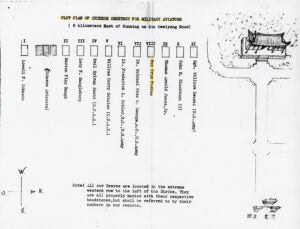COLUMN: A Flying Tiger from South Alabama: The Story of Ben Crum Foshee and the American Volunteer Group – Conclusion
Published 1:00 pm Friday, December 8, 2023

- LEFT: Ben Crum Foshee beside hia P-40 Warhawk #97 at Kunming airfield in China. [Photo: FLICKR and The San Diego Air and Space Museum] TOP RIGHT: Hells Angels, 3rd pursuit squadron, American Volunteer Group in flight over China in 1942. [Photo taken by Robert Taylor, AVG pilot] BOTTOM RIGHT: Walt Disney designed the "Flying Tiger" image for the AVG. [Photo: Pinterest]
|
Getting your Trinity Audio player ready...
|
From their first battle against the Japanese on December 20, 1941, members of the American Volunteer Group were only in combat for seven months. The Japanese had the advantage of numbers and in most cases with superior aircraft. Just how did such a small force make such an impact on the Japanese war machine?
The man behind the success of the Flying Tigers didn’t believe in luck. Col. Claire Chennault had been a skilled fighter pilot. He had studied the capabilities and methods used by the Japanese. He taught his pilots the limitations of the P-40. The AVG used a two-aircraft formation against the Japanese, attacking from above using the P-40’s superior diving speed. They used hit-and-run tactics and never fought the Japanese on even terms.
Even with Chennault’s training and tactics, the AVG lost planes. They were constantly salvaging parts from crashed aircraft. Occasionally, they were able to obtain new P-40s. In March 1942, Col. Chennault was notified that the AVG had four new planes to be picked up in Accra, Ghana, on the west coast of Africa. He dispatched the Hell’s Angels Flight Leader, George McMillan, Ben Foshee and two other pilots to Ghana, to pick up four brand new P-40E aircraft.
The roundtrip to Ghana was some 14,000 miles. They returned to China by way of Nigeria, Sudan, Egypt, Bahrain and Pakistan. Foshee wrote his mother from Cairo on March 9, 1942, on stationery from the Grand Hotel, Cairo, “Everything has been fine in China and the fellows have done a wonderful job in Burma. Enclosed is a clipping from a Cairo paper. This dinner was given after I left but I got to meet Madam before. We hope to get back to China soon. We are flying some fighting planes back.” Foshee was referring to Madame Chiang Kai-Shek, the wife of the Generalissimo. He had met her before while flying as Col. Chennault’s personal pilot.
His letter continued, “The trip over was real nice. Got to see all the old cities here around the Holy Grounds. I’m also sending a few snaps I took around the pyramids and sphinx, and also a picture of me with my Chinese uniform on. The star on my cap is the Chines insignia and the other is the insignia for the American Volunteer Group. Also, the wings are Chinese…Hope everyone is well. Have you been getting my radiograms? My address is Box 104; Kunming, Younnan, China…Love to all, Ben.”
The four pilots returned to their base at Kunming in late March. On April 29, Bob Neale, Ben Foshee and two other pilots flew four planes from Kunming to Paoshaun field. The city of Paoshaun was crowded with refugees fleeing the Japanese advance. The AVG anticipated an attack on the city of Paoshaun and hoped to intercept the bombers.
On May 4, 50 Japanese bombers managed to slip through the Chinese early warning net and bombed Paoshaun. When the bombs began to fall, all four AVG pilots raced for their aircraft. Only Charley Bond managed to get off the ground. Ben Foshee suffered severe leg wounds from bomb fragments as he rushed to his plane. He bled to death before “Doc” Richards [one of the AVG doctors] could reach him. Foshee died less than two months after returning to China, and only two months before the AVG was disbanded on July 4, 1942. Ben Crum Foshee was buried at the Chinese Cemetery for Military Aviators, located about five miles east of Kunming.

Monument for Ben Crum Foshee in the Fairmount Baptist Church Cemetery, Red. Level, AL. It was placed to face north and south so that his mother could see it from the road. [Photo: Sue Wilson]
The family received official notification in correspondence dated May 18, 1942. It was from Richard Aldworth of the Central Aircraft Manufacturing Company in China. It read, “It was with deep regret that I had to send the formal telegram required of me…We do not have any details as yet in this office other than those already known to you. However, we do know that Ben did his duty to the last and if one has to go in the first flush of manhood, surely there is no better way. His comrades and his country may indeed be very proud of him.
He continued, “He was a splendid example of fine American manhood and exemplified the spirit of the AVG, to give of his best to the limit. The spirit of these boys, who have given their lives in such a worthy cause, will live forever.”

Plot of Ben Crum Foshee’s grave within the Chinese Cemetery for Military Aviators near Kunming, China. [Photo: Paul Frillmann, 1st Lt. A.C., AAFAIS, Harrisburg, Pa.]
After giving a brief background of Foshee’s life, the article continued, “Foshee was 27 years of age. His family last heard from him three weeks ago…Young Foshee’s life will be memorialized over the CBS radio Program, ‘They Live Forever,’ at 9:30 Sunday night, according to a CBS representative who contacted the family this week.”
The family held a funeral for Ben at the Long Branch Baptist Church in Cohassett. However, It was not until 1946 that Ben Crum Foshee’s body was returned home for burial. In the 2008 interview, Wheeler Foshee Sr. recalled, “My grandmother completely lost her mind after Ben’s death. She buried him in the Fairmount Cemetery facing the wrong direction.”
Foshee family members stated that Ben’s mother had his body buried facing north and south so that she could see the marker from the road without getting out of the car.
The family paid a retired Navy commander to travel to China and have Ben Foshee’s body returned to the States. When the body was returned for the funeral, it was escorted by Sgt. Charles Brown of Fort Benning, Georgia. The funeral was held Nov. 1, 1946, at the Fairmount Baptist Church of Red Level. Burial was in the church cemetery with full military honors provided by the Red Level American Legion Post. Survivors included his mother, Ella Parker Foshee; three brothers, Luman Julian, Wheeler George and Horace Greely Foshee; and two sisters, Mary Ella “Dot” Foshee and Annie Lee Foshee Gantt.
John Vick
The author would like to thank Sue Bass Wilson for the use of her extensive files on Ben Crum Foshee. Sue, Richard Daniel and others were responsible for getting the firehouse at the South Alabama Regional Airport named for Ben Crum Foshee in 2010.
Author’s note: Most military experts in the States thought the American Volunteer Group might last a few weeks in combat. In fact, they fought the Japanese in the skies of China, Burma, Thailand and Indochina for about seven months. They were credited with destroying 229 aircraft in the air and another 62 on the ground. They probably shot down another 100 that could not be confirmed. The AVG lost four pilots killed in combat, six by anti-aircraft fire, three by enemy bombs on the ground and three were taken prisoner. Their remarkable success came at a time of low morale in the United States and the world. The Flying Tigers’ reputation for daring and courage was memorialized for all time in a number of movies and a great number of books.
[Sources: Wikipedia; “The Flying Tiger – The True Story of General Claire Chennault and the U.S. 14th Air Force in China,” by Jack Samson; “Ding Hao – America’s Air War in China, 1937-1945,” by Wanda Cornelius and Thayne Short; May 24, 2008 article in the Andalusia Star-News, “Flying Tiger Hero Foshee Remembered,” by Michele Gerlach; May 14, 1942 article in The Evergreen Courant, “Ben Foshee Loses Life in China”]





